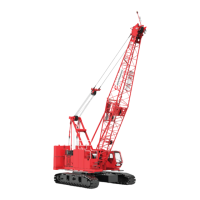HOISTS MLC80A-1/MLC90A-1/MLC100A-1/MLC100-1 SERVICE/MAINTENANCE MANUAL
5-32
Published 10-09-2020, Control # 259-06
use only pre-assembled lengths of wire rope as supplied
from Manitowoc Cranes. Do not build lengths from
individual components.
• Replace an entire wire rope assembly. Do not attempt to
rework damaged wire rope or wire rope ends.
• Never electroplate a wire rope assembly.
• Do not weld any wire rope assembly or component
unless welding is recommended by the wire rope
manufacturer.
• Welding spatter must never be allowed to come in
contact with the wire rope or wire rope ends. In addition,
be sure that the wire rope is not an electrical path during
other welding operations.
• Wire ropes are manufactured from special steels. If
heating a wire rope assembly is absolutely necessary for
removal, the entire wire rope assembly must be
discarded.
• On systems equipped with two or more wire rope
assemblies operating as a matched set, they must be
replaced as an entire set.
• Do not paint or coat wire ropes with any substance
except approved lubricants.
Daily Inspection
Wire rope should be inspected in accordance with ANSI/
ASME B30.5 and OSHA 29 CFR 1926.1413. A running
record of the condition of each wire rope should be noted in
the equipment inspection log.
• Each workday, prior to crane work, visually inspect all
rope that can reasonably be expected to be used that
day. Check for obvious damage, including the following:
- Rope defects (see Figure 5-21
)
- Loss of rope diameter (see Reduction in the Rope
Diameter on page 5-34)
- Distortion to the uniform structure of the rope
- Broken wires—Record the number, distribution, and
type of broken wires (see Broken Rope Wires on
page 5-34)
- Internal wear or broken wires for ropes operating on
nylon sheaves. Common indicators of internal
deterioration include localized reduction in the rope
diameter, corrosion between the strands, localized
lengthening of lay, wire displacement, or wire
distortion.
- Gross damage, deterioration, or corrosion to the
end connections
- Evidence of heat, electrical, or lightning damage
- Localized change in lubrication condition
- Minor or general corrosion
- Areas that deteriorate more rapidly, such as the
flange points, the crossover points, and the
repetitive pickup points on the drums
- Take special care to observe the boom hoist ropes
and rotation-resistant ropes for evidence of core
failure or other deterioration (remove from service)
- Internal deterioration of rotation-resistant ropes may
not be readily observable
• Throughout the day, observe the wire rope during
operation, particularly at the following locations:
a. Repetitive wear points, such as the following:
- Flange step-up, crossover, repetitive pickup
points on drums
- Reverse bends in the reeving systems
- Equalizer sheaves
- End connections
- Sheave or drum groove wear or corrugation
b. Known wear areas based on previous experience or
inspections
c. Locations where rope vibrations are reduced, such
as the following:
- Sections is contact with equalizer or other
sheaves where rope travel is limited
- Sections of the rope at or near end connections
where corroded or broken wires may protrude
- Rope at the reverse bends in the boom hoist or
luffing hoist reeving
- Repetitive pickup points, crossovers, and
change of layers at flanges on the drums
- Fleeting or deflector sheaves
WARNING
Personal Injury Hazard!
Prior to conducting an inspection of wire rope:
• Lockout-tagout the crane when removing or installing
the wire rope assemblies.
• Use safety glasses for eye protection.
• Wear protective clothing, gloves, and safety shoes as
appropriate.
• Use supports and clamps to prevent uncontrolled
movement of the wire rope, parts, and equipment.

